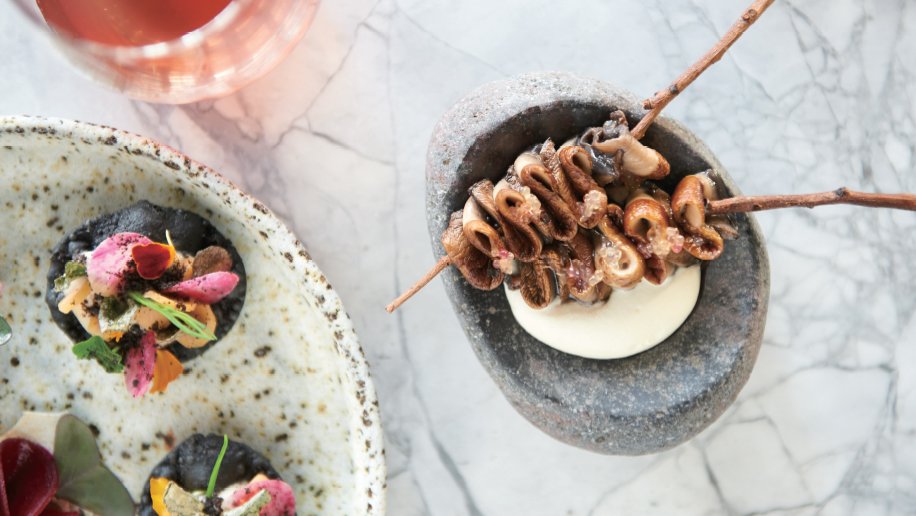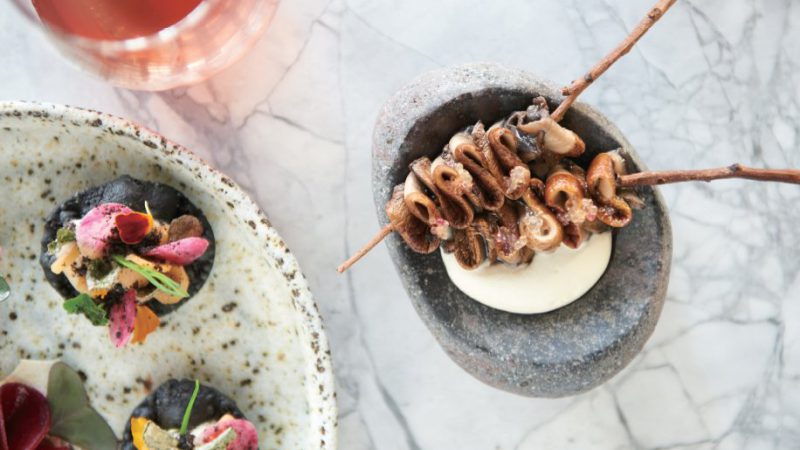Bush Food Blossoms
September 30, 2019


It’s often said that Australia doesn’t really have its own national cuisine – that as a young country, its food culture is best understood as a mosaic of traditions drawn from Asia, the Mediterranean, the Middle East and Europe, blended together and adapted to suit Australian produce and palates.
On one level, this is true. On another level, it disregards the rich history of everything Indigenous Australians ate pre-colonization. Sure, the macadamia nut has achieved international recognition, but what about the thousands of other edible native species? Even five years ago, for the interested diner to experience native Australian produce, they’d have to seek out a specialist, capital “F” Fine Dining restaurant like Ben Shewry’s Attica or Jock Zonfrillo’s Orana in order to sample the country’s endemic produce.
Lately, it seems this is changing. Across Australia, an influx of casual eateries – the kind that eschew tablecloths and stuffiness and excel in moderately priced wine lists – are serving up modern cuisine with a distinctive Indigenous flavor.
Etta
Take Etta, for example. Led by New Zealand-born chef Hayden McMillan and his business partner Hannah Green, the Brunswick East, Melbourne bistro acts as a gentle gateway to the possibilities of bush food.
“For me, it comes down to flavor,” explains McMillan. “At Etta, we want to give people something that they’ve never had before, but it’s really driven by flavor.” What he means by this is that the food isn’t designed to be challenging; it has none of the conceptual pomp you’d find at somewhere like Attica.
Instead, Etta aims to please. With a menu reflecting the “melting pot of cultures” that make up the local neighborhood, Greek, Italian, Middle Eastern, Asian and Indigenous Australian influences all find their way into the bright, produce-driven fare.
McMillan deploys native Australian ingredients with flair, using them as unexpected accents to more familiar flavors. Wattleseed, a spice prized for its flavor profile that sits somewhere between coffee, chocolate and hazelnut, is made into a dukkah and served atop a dish of heirloom carrots and salted ricotta, or used as a spice rub in curing meat. Blue-grey leaves of saltbush are fried to a crisp and plated with golden roast potatoes or a tangle of green beans with sauce gribiche. Its appeal, says McMillan, is in its texture: “I’ll use saltbush if I want to add a layer of salt and crunch to something.”
Another standout ingredient is finger lime, a roughly cylindrical green-skinned fruit which, split open, reveals an inside full of luminous pearls resembling caviar. Its pulp is used at Etta across both savory and sweet dishes – the zippy flavor pairing equally well with Ora King salmon as it does atop a perfectly balanced dessert of cheesecake, tart mandarin sorbet and ginger caramel.
“It adds so much surprise to the palate,” explains McMillan. “You can be eating something and then it’s pew! pew! pew!” (he mimes a series of small explosions with his hands). “It’s easily my favorite indigenous ingredient.”
Sunda
At Sunda, a modern, buzzy eatery in Melbourne’s CBD, the Vietnamese, Malaysian and Indonesian-influenced menu is similarly reflective of Australia’s multicultural make-up. Chef Khanh Nguyen learned his trade at Sydney’s Red Lantern, Bécasse and Mr Wong before landing an internship at René Redzepi’s Noma pop-up. It was there that he became interested in the possibilities of native, foraged foods.
“When I did the internship with René, I asked him why he uses native ingredients. He said that’s just who he is,” says Nguyen. “He gave me the advice that if you just be yourself, you’ll be unique. I was born in Australia, but my parents are Vietnamese and so I took that on and did Southeast Asian flavors with native ingredients.”
Familiar dishes like congee, laksa, nasi ulam and roti are reimagined with a distinctly Australian twist – the laksa, for instance, uses the leaves and stalks of Geraldton wax in place of lemongrass, its slightly bitter, acidic flavor imparting a unique dimension to the broth. The nasi ulam is served with native herbs like aniseed myrtle rather than the traditional Malay ingredients. The congee gets a hit of earthiness from wattleseeds.




